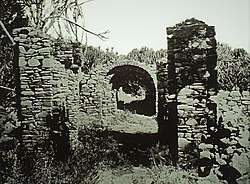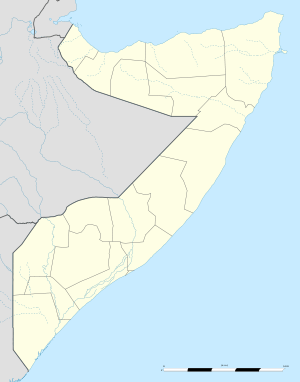Abasa, Awdal
Abasa is an ancient town in the northwestern Awdal region of Somalia.[1]
Abasa | |
|---|---|
Ancient ruin | |
 Ruins of an Ancient Mosque in Abasa | |
 Abasa Location in Somaliland. | |
| Coordinates: 10°08′00″N 43°13′00″E | |
| Country | |
| Province | Awdal |
| Time zone | UTC+3 (EAT) |
Overview

Abasa is situated about 15 km to the east of Boon, Awdal.
Philip Briggs (2012) describes Abasa:
"Abasa, the most impressive of the ruins around Borama, is accessible by 4x4 only. It's a bone rattling 2-hour drive that entails following the Zeila road northwest, then heading northeast to the village of Bon (or Bown), before taking a rough 15km track to the east."[2]
A large town, it features numerous ruined structures stretching over a wide area. The buildings were built in a rectangular style, and the now ruined Abasa Mosque has large columns of two different types: cylindrical and cruciform. 14th to 16th century Islamic pottery and Chinese sherds have also been found here, which are believed to be relics from the Adal Sultanate's commercial activities.[1]
Richard Francis Burton (1856) describes traditional Gadabuursi tomb and burial practices in Abasa in great detail in his book First Footsteps in East Africa:
"At 9 A.M. we crossed the Lesser Abbaso, a Fiumara with high banks of stiff clay and filled with large rolled stones: issuing from it, we traversed a thorny path over ascending ground between higher hills, and covered with large boulders and step-like layers of grit. Here appeared several Gadabursi tombs, heaps of stones or pebbles, surrounded by a fence of thorns, or an enceinte of loose blocks: in the latter, slabs are used to make such houses as children would build in play, to denote the number of establishments left by the deceased. The new grave is known by the conical milk-pails surmounting the stick at the head of the corpse, upon the neighbouring tree is thrown the mat which bore the dead man to his last home, and hard by are the blackened stones upon which his funeral feast was cooked."[3]
Richard Francis Burton (1856) describes the Abasa Valley:
"At half past three reloading we followed the course of the Abbaso Valley, the most beautiful spot we had yet seen. The presence of mankind, however, was denoted by the cut branches of thorn encumbering the bed: we remarked too, the tracks of lions pursued by hunters, and the frequent streaks of serpents, sometimes five inches in diameter."[4]
Demographics
The region around the ancient town is inhabited by the Reer Ahmed branch of the Jibriil Yoonis, a subclan of the Gadabuursi Dir clan.[5]
Notes
- Chittick, Neville (1975). An Archaeological Reconnaissance of the Horn: The British-Somali Expedition. pp. 117–133.
- Briggs, Philip (2012). Somaliland: with the overland route from Addis Ababa via eastern Ethiopia (1st ed.).
- Burton, Richard (1856). First Footsteps in East Africa (1st ed.). Longman, Brown, Green, and Longmans.
At 9 A.M. we crossed the Lesser Abbaso, a Fiumara with high banks of stiff clay and filled with large rolled stones: issuing from it, we traversed a thorny path over ascending ground between higher hills, and covered with large boulders and step-like layers of grit. Here appeared several Gudabirsi tombs, heaps of stones or pebbles, surrounded by a fence of thorns, or an enceinte of loose blocks: in the latter, slabs are used to make such houses as children would build in play, to denote the number of establishments left by the deceased. The new grave is known by the conical milk-pails surmounting the stick at the head of the corpse, upon the neighbouring tree is thrown the mat which bore the dead man to his last home, and hard by are the blackened stones upon which his funeral feast was cooked.
- Burton, Richard (1856). First Footsteps in East Africa (1st ed.). Longman, Brown, Green, and Longmans.
At half past three reloading we followed the course of the Abbaso Valley, the most beautiful spot we had yet seen. The presence of mankind, however, was denoted by the cut branches of thorn encumbering the bed: we remarked too, the tracks of lions pursued by hunters, and the frequent streaks of serpents, sometimes five inches in diameter.
- Hayward, R. J.; Lewis, I. M. (2005-08-17). Voice and Power. Routledge. ISBN 9781135751753.